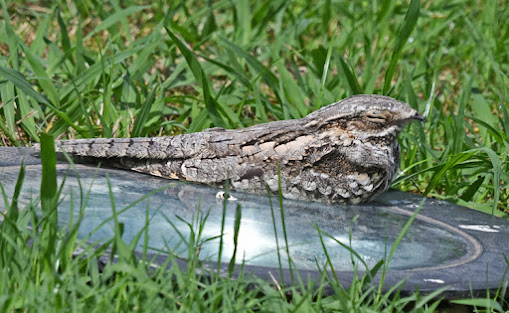October proved to be an exceptionally warm month, but also an extremely wet one. Temperatures reached 20C on a few occasions throughout the month, but torrential rain on the 20th produced 54mm, making this day wetter than any single preceding month this year! All told, 112mm fell in the month, according to my rain gauge. However, invertebrate numbers dropped away after the first few days and the emphasis for the rest of the month was on bird watching. Butterflies on the wing in the first week included common blue (several sightings), small copper, peacock, red admiral, brimstone, speckled wood, and small and large whites. A visit to the Old Rifle Range on the 3rd produced more than one female Adonis blue, including a specimen that was in surprisingly good condition (image). A late holly blue was seen close to my house on a glorious, sunny day on the 18th. Ivy bees were still active until near the end of the month, as were field crickets and hairy shield bugs. A hornet was seen in Therfield on the 6th, when I did my long walk around the villages.
Thursday 13 October 2022
Local Wildlife Sightings October 2022
UK Wildlife Sightings October 2022
My first proper outing of October had to wait until the 12th, when I visited the North Norfolk coast. Winds had been blowing from the west throughout the month, so vagrant rarities were virtually non-existent. However, I had hoped to see black-throated diver (birds reported from a number of locations) and the hooded crow that had taken up residence at Warham Greens. Of course, there was always the photography to look forward to!
I started at Holkham, walking down Lady Anne's drive to the beach. There were plenty of pink-footed geese around, both in the fields and flying overhead, and I spotted a couple of grey partridge close to the car parking area. The usual area of the beach had been cordoned off, but there was no sign yet of wintering shorelarks or snow buntings. A few common scoters and great crested grebes were on the sea and a couple of razorbills flew west. More distant birds (I didn't have my 'scope with me) could have been divers. However, there was one diver close inshore, which allowed me to take some photographs. This was probably a sick bird, which made no attempt to fly or swim away (hopefully not bird flu). My images indicated that this was an adult red-throated diver, moulting into winter plumage.
Georgia (Batumi) September 2022
Back in early 2020 I booked a holiday with 'Naturetrek' to visit Georgia, to witness the raptor migration and to enjoy exploring the area around the Black Sea coastal city of Batumi looking for some of the special birds that live in or pass through the area. The trip was twice postponed because of Covid, but eventually, on 19 September, it was 'all systems go'. An overnight flight saw our bleary-eyed party of six finally arrive in Batumi late on the morning of the 20th. After ditching luggage at our hotel, it was straight up into the Lower Caucasus mountains to 'Watch Point One', which we were to visit twice more on the holiday. We had been promised the sight of hundreds or maybe thousands of Steppe buzzards migrating south past the watch point in the blurb, but it soon became obvious that the dominant species was black kite, with 'kettles' of 100+ birds passing through. Honey buzzards were also much in evidence, with small numbers of Steppe buzzards, black storks, common and Levant sparrowhawks and a handful of short-toed and booted eagles coming through. Smaller birds on migration included bee-eaters and rollers. A handful of passerines in the area included spotted flycatchers and a green warbler, the only one that was seen on the holiday.



















